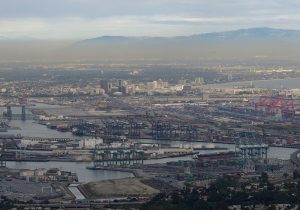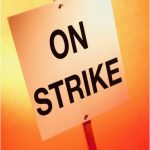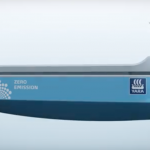Ports of LA & LB Release Clean Air Action Plan for Public Comment

Smog over the Port of Los Angeles PICTURE: Nick C. Prior
A draft of the 2017 Clean Air Action Plan (CAAP) update has been released by the Ports of Los Angeles and Long Beach. You have between now and September 18th to submit written comments on it.
An updated CAAP was promised back in June when Los Angeles Mayor Eric Garcetti and Long Beach Mayor Robert Garcia signed a pact to update the plan with targets of zero emissions in the cargo handling machinery and trucks of the Ports of Los Angeles and Long Beach.
You would think the Port of Los Angeles Executive Director’s name was Gene Roddenberry rather than Gene Seroka based on his words upon the release of the 2017 CAAP update draft:
“These ports are going where no port has gone before.”
Obviously, there is excitement from the port directors upon releasing a plan that, if executed, would make the Ports of Los Angeles and Long Beach the greenest, cleanest, technologically-advanced-machine-est in the world.
[Seroka continued,] “Based on what we’ve already accomplished to promote healthy, robust trade through our gateway, we’re ready to make history again, looking at a new array of technologies and strategies to further lower port-related emissions in the decades ahead.”“Working closely with all our partners has been crucial to our success. That same collaboration went into the development of the 2017 CAAP and will be indispensable going forward,” said Port of Long Beach Executive Director Mario Cordero. “Since 2006, the Clean Air Action Plan has been a model for programs to reduce health risks and air quality impacts from port operations worldwide. We remain committed to being leaders in seaport sustainability.”
Those are certainly nice words from the directors of the ports, but what exactly are the strategies the updated plan proposes to utilize to reach its lofty zero emissions goals?
The ports’ joint press release lists the strategies, grouped under four categories:
Clean Vehicles, Equipment Technology and Fuels
- Starting in 2018, phase in clean engine standards for new trucks entering the port drayage registries followed by a truck rate structure that encourages the use of near-zero and zero emissions trucks, with the goal of transitioning to a zero emissions drayage fleet by 2035.
- Reduce idling and support the state’s efforts to transition terminal equipment to zero emissions by 2030.
- Update the Vessel Speed Reduction Program, expand the use of state-approved alternative technologies to reduce at-berth emissions, and encourage clean technology upgrades on ships to attract the cleanest vessels to the San Pedro Bay ports.
Freight Infrastructure Investment and Planning
- Expand use of on-dock rail, with the long-term goal of moving 50 percent of all inbound cargo leaving the ports by rail.
- Develop charging standards for electric cargo handling equipment.
Freight Efficiency
- Develop a universal truck appointment system for the entire complex with the goal of minimizing truck turn times.
- Create a voluntary Green Terminal Program to recognize terminal operators achieving high levels of freight movement efficiency.
- Continue to explore short-haul rail, staging yards, intelligent transportation systems and other supply chain efficiency improvements.
Energy Resource Planning
- Develop infrastructure plans to support terminal equipment electrification, alternative fuels and other energy resource goals.
- Continue to develop and implement viable energy conservation, resiliency and management strategies.
The plan was just released on Wednesday (July 19th), but already there is plenty of criticism.
The Los Angeles Times published an article by Tony Barboza that headlines with the plan could cost $14 billion.
Barboza’s excellent article highlights a number of the criticisms of the plan, many of them coming down to the money it would cost to be realized:
One of the biggest questions raised Wednesday by industry and environmentalists was how the thousands of new trucks and pieces of equipment would be paid for — not to mention how quickly the change-over realistically could happen.
…
While environmentalists welcomed many elements of the plan, they criticized its lack of new targets for reducing smog-forming emissions as well as measures to ensure speedy progress and ease pollution-triggered health problems.
“The plan relies too heavily on yet-to-be-developed state regulations, millions in yet-to-be-located subsidies and voluntary programs,” said Melissa Lin Perrella, an attorney with the Natural Resources Defense Council. “At the end of the day, we have to ask if the words on paper will make the air safe to breathe. The plan is not there yet.”
And industry groups and truckers expressed big concerns about the price tag.
…
Weston LaBar, executive director of the Harbor Trucking Assn., said it was important “that we don’t saddle an industry that has invested billions of dollars in clean technology with a mandate that is not viable commercially or operationally.”
…
Business groups said the plan will place too heavy a burden on Southern California’s economy and put its freight-moving industries at a disadvantage at a time of increasing competition with other seaports.
Barboza’s article does much more than cover the criticisms of the plan and is certainly worth a read.
However, if you are really interested in the plan and concerned with its feasibility and potential impact, you can read the 2017 CAAP update itself by clicking here.
After you’ve read the plan for yourself, you can let your voice be heard in two ways.
The first way is by submitting written comments to CAAP@cleanairactionplan.org by 5 pm on September 18th.
The second is to attend a CAAP public workshop at 5 pm on August 30th at Banning’s Landing Community Center, located at 100 Water St. in Wilmington.




